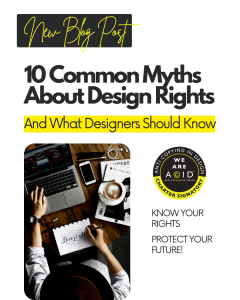

Many ACID members are still confusing officially registering a design with an Intellectual Property Office and lodging unregistered designs (and copyright works) on the IP Databank, so we thought we would answer some of the frequently asked queries so that there is clarity and no confusion!
The majority of the thousands of settlements on behalf of ACID members have been based on unregistered design rights. Enforcement of unregistered design right infringement is only as good as the evidence you can provide to substantiate ownership. Unregistered Design right only protects the shape or configuration of a 3D product* (see above as from Jan 1st, 2021). The majority of UK (and EU) designers rely on unregistered design rights which is why ACID set up the IP Databank to offer an alternative strand to evidence creating.
Spread the Word

Latest News





Newsletter Sign-Up
| Cookie | Duration | Description |
|---|---|---|
| cookielawinfo-checkbox-analytics | 11 months | This cookie is set by GDPR Cookie Consent plugin. The cookie is used to store the user consent for the cookies in the category "Analytics". |
| cookielawinfo-checkbox-functional | 11 months | The cookie is set by GDPR cookie consent to record the user consent for the cookies in the category "Functional". |
| cookielawinfo-checkbox-necessary | 11 months | This cookie is set by GDPR Cookie Consent plugin. The cookies is used to store the user consent for the cookies in the category "Necessary". |
| cookielawinfo-checkbox-others | 11 months | This cookie is set by GDPR Cookie Consent plugin. The cookie is used to store the user consent for the cookies in the category "Other. |
| cookielawinfo-checkbox-performance | 11 months | This cookie is set by GDPR Cookie Consent plugin. The cookie is used to store the user consent for the cookies in the category "Performance". |
| viewed_cookie_policy | 11 months | The cookie is set by the GDPR Cookie Consent plugin and is used to store whether or not user has consented to the use of cookies. It does not store any personal data. |